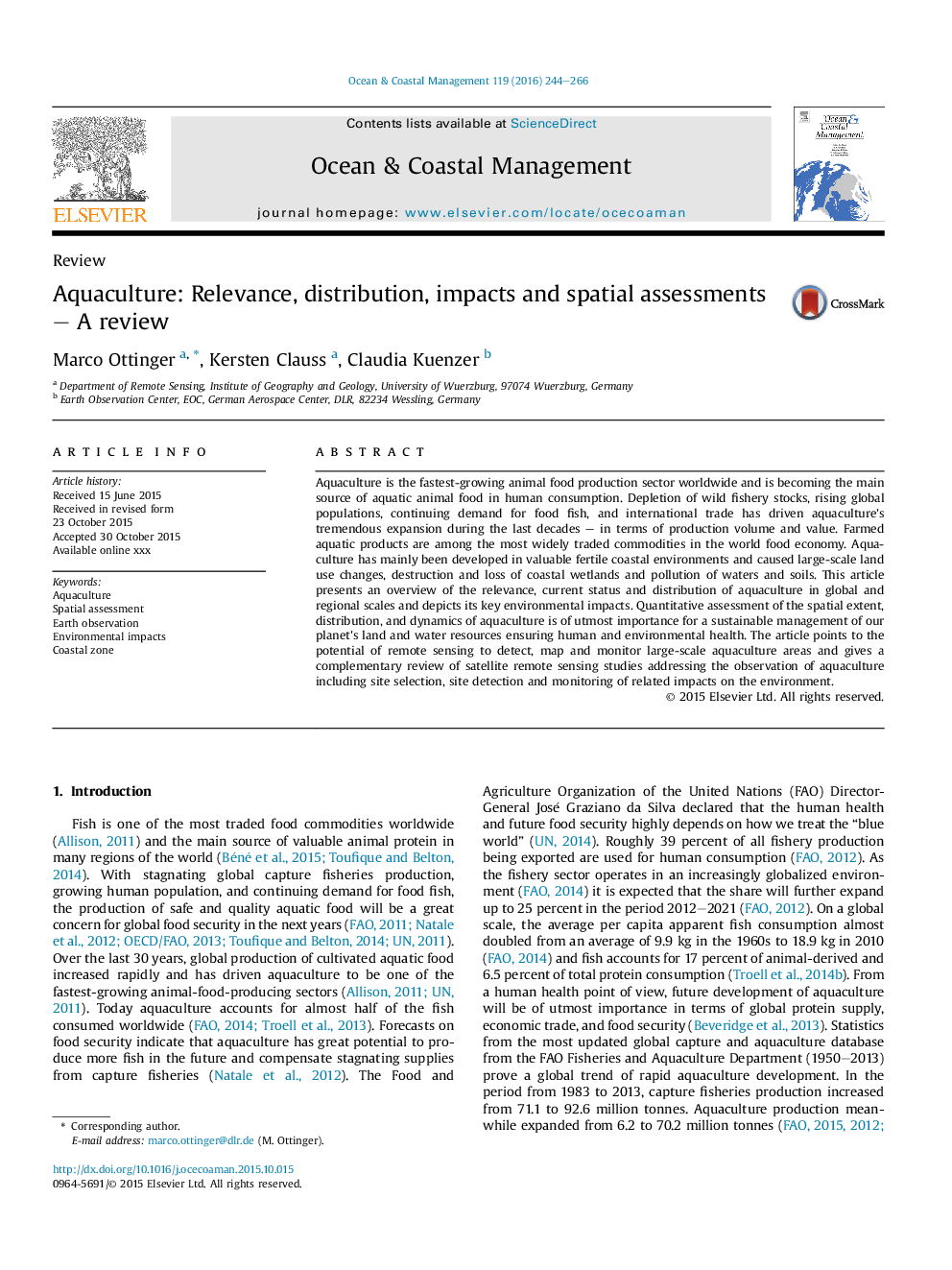| کد مقاله | کد نشریه | سال انتشار | مقاله انگلیسی | نسخه تمام متن |
|---|---|---|---|---|
| 8061295 | 1520510 | 2016 | 23 صفحه PDF | دانلود رایگان |
عنوان انگلیسی مقاله ISI
Aquaculture: Relevance, distribution, impacts and spatial assessments - A review
ترجمه فارسی عنوان
آبزی پروری: اهمیت، توزیع، اثرات و ارزیابی فضایی - بررسی
دانلود مقاله + سفارش ترجمه
دانلود مقاله ISI انگلیسی
رایگان برای ایرانیان
کلمات کلیدی
آبزی پروری، ارزیابی فضایی، مشاهده زمین، اثرات زیست محیطی، منطقه ساحلی،
ترجمه چکیده
آبزی پروری سریعترین بخش تولید غذای حیوانات در سراسر جهان است و تبدیل شدن به منبع اصلی غذاهای حیوانی آبزی در مصرف انسان است. از بین رفتن ذخایر ماهیگیری وحشی، افزایش جمعیت جهانی، ادامه تقاضا برای ماهی های مواد غذایی و تجارت بین المللی، رشد عظیم آبزی پروری طی دهه های گذشته - از لحاظ حجم تولید و ارزش تولید شده است. محصولات آبیاری مزرعه یکی از کالاهائی است که به طور گسترده در تجارت جهانی مواد غذایی مورد استفاده قرار می گیرد. آبزی پروری به طور عمده در محیط های ارزشمند بارانی ساحلی توسعه یافته و باعث تغییرات عملیاتی در زمینه استفاده از زمین، تخریب و از دست دادن تالاب های ساحلی و آلودگی آب و خاک شده است. این مقاله خلاصه ای از ارتباط، وضعیت فعلی و توزیع آبزی پروری در مقیاس جهانی و منطقه ای را ارائه می دهد و تاثیرات کلیدی محیطی آن را نشان می دهد. ارزیابی کمی از وسعت فضایی، توزیع و پویایی آبزی پروری برای مدیریت پایدار زمین و منابع آب در این سیاره، حصول اطمینان از سلامت انسان و محیط زیست، بسیار مهم است. این مقاله به پتانسیل سنجش از راه دور برای شناسایی، نقشه برداری و نظارت بر مناطق آبزی پروری بزرگ اشاره می کند و به بررسی تکمیلی از مطالعات سنجش از دور ماهواره ای مربوط به مشاهده آبزی پروری از جمله انتخاب سایت، تشخیص سایت و نظارت بر تأثیرات مرتبط با محیط زیست اشاره می کند.
موضوعات مرتبط
مهندسی و علوم پایه
علوم زمین و سیارات
اقیانوس شناسی
چکیده انگلیسی
Aquaculture is the fastest-growing animal food production sector worldwide and is becoming the main source of aquatic animal food in human consumption. Depletion of wild fishery stocks, rising global populations, continuing demand for food fish, and international trade has driven aquaculture's tremendous expansion during the last decades - in terms of production volume and value. Farmed aquatic products are among the most widely traded commodities in the world food economy. Aquaculture has mainly been developed in valuable fertile coastal environments and caused large-scale land use changes, destruction and loss of coastal wetlands and pollution of waters and soils. This article presents an overview of the relevance, current status and distribution of aquaculture in global and regional scales and depicts its key environmental impacts. Quantitative assessment of the spatial extent, distribution, and dynamics of aquaculture is of utmost importance for a sustainable management of our planet's land and water resources ensuring human and environmental health. The article points to the potential of remote sensing to detect, map and monitor large-scale aquaculture areas and gives a complementary review of satellite remote sensing studies addressing the observation of aquaculture including site selection, site detection and monitoring of related impacts on the environment.
ناشر
Database: Elsevier - ScienceDirect (ساینس دایرکت)
Journal: Ocean & Coastal Management - Volume 119, January 2016, Pages 244-266
Journal: Ocean & Coastal Management - Volume 119, January 2016, Pages 244-266
نویسندگان
Marco Ottinger, Kersten Clauss, Claudia Kuenzer,
